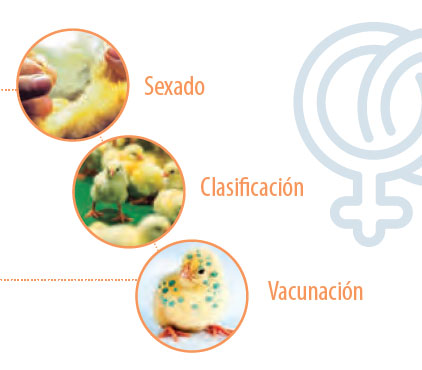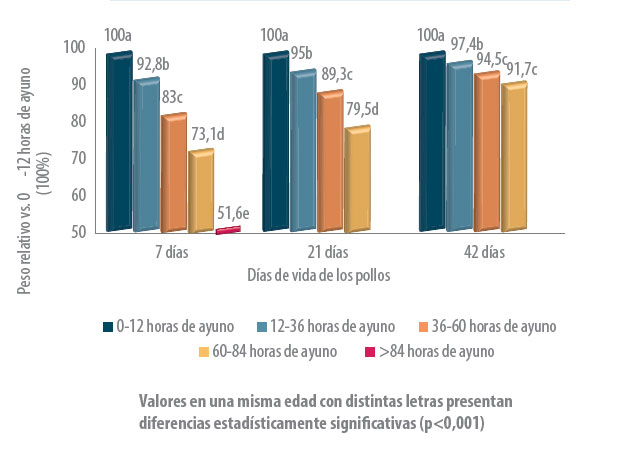Content available at: Español (Spanish)
In this review, various strategies are presented for feeding chicks post hatch, from the first hours of life in the hatchery until their first few days on the farm.

In commercial hatcheries, newly hatched chicks remain in the incubators for a certain number of hours until they proceed with their sexing, sorting, vaccination, etc. Once all these tasks are completed, the chicks are transported to the farm. Sometimes it can take up to 72 hours between the moment the hatching process is finalized, until the chicks get access to feed and water, depending on the distance between the hatchery and the destination farm.
Chicks are generally considered to be able to survive on their yolk sac reserves for a period of up to approximately 72 hours after hatching –Mitchell, 2009–.
However, while the yolk sac reserves may be sufficient for survival, the absence of feeding during the first hours or days of life can negatively affect the growth and productive performance of chickens throughout their lives.
Recently, De Jong et al. –2017– carried out a rigorous meta-analysis based on 83 experimental tests in which the effect of fasting time during the first hours of life on the weight and productive performance of chickens at different ages was studied. This meta-analysis revealed that, although chicks can compensate for the growth delay derived from fasting during the first hours of life, this compensation is not complete, with statistically significant differences still being observed in live weight at 42 days of age, depending on of the number of hours they remained without feed after hatch –Figure 1–.

Figure 1. Effect of hours of fasting after hatching on live weight of chickens at different ages –de Jong et al., 2017 –
Similarly, the number of hours of fasting after hatching significantly affects the index conversion rate –Figure 2– and mortality throughout the broadening of chickens –Figure 3–.

Figure 2. Effect of fasting hours after hatching on the conversion rate of chickens from 0 to 24 days old –de Jong et al., 2017 –
In addition to feeding as early as possible, the proportion of macronutrients in the first feeding that the chicks receive is decisive for their growth throughout their lives, with protein intake during the first days of life being the most important nutritional factor.
Keep up to date with our newsletters
Receive the magazine for free in digital version REGISTRATION ACCESS
YOUR ACCOUNT LOGIN Lost your password?
Figure 3. Effect of fasting hours after hatching on the mortality of chickens from 0 to 24 days of age –de Jong et al., 2017 –
The delay of the chicks’ access to feed and water after hatching, negatively affects their weight, performance and mortality until the end of growing
Swennen et al –2010– fed newborn chicks up to five days old with a low-protein, low-carbohydrate, or low-lipid prestarter diet, with the three diets being isoenergetic. Later, from the sixth day of life, all chickens received the same commercial diets until 42 days of life.
The results of this study demonstrated that the chicks that had received the low-protein pre-starter diet lagged in growth compared to those that had received the low-carbohydrate or low-fat pre-starter feeds –Figures 4 and 5–. This is explained by the fact that the efficiency of protein digestion is lower than that of lipids and carbohydrates in the first days after hatching –Noy and Sklan, 1995–.
Figure 4. Effect of the composition of the pre-starter diet on the growth of chicks from 0 to 7 days old –Swennen et al., 2010 –
Figure 5. Effect of pre-starter diet composition on the growth of chicks between 7 and 42 days old –Swennen et al., 2010 –
The digestibility of dietary protein and amino acids is relatively low up to 10 days –Figure 6– and, consequently, the inclusion of highly digestible protein sources in the pre-starter diets is crucial to strengthen the growth of the chicks.
Figure 6. Lysine digestibility in chicks from 0 to 20 days old –Batal and Parsons, 2002
As already mentioned in this article, access to feed – and water – immediately after hatching is of utmost importance for the optimal development of the digestive and immune system of the chicks and, in particular, is decisive for laying the foundation for their growth and overall health. Today there are feed and water management systems for chicks in hatchers, hatcheries and even during transport.
In these systems, the hatching trays have gaps between the egg sockets, through which the newly hatched chicks fall into a lower basket where there are feeders on both sides with enough feed for 24-36 hours –Photo 1–.
Photo 1. Feed right after hatch. Photo courtesy of HatchTech.
Another practice on the rise is the use of moisturizing gels that contain an increasing variety of nutrients and additives such as vitamins or probiotics. These gels are sprayed as droplets on the chick boxes in the hatchery. The chicks consume the gel droplets voraciously when pecking – in less than a minute – and consequently ingest the nutrients contained therein; all without getting wet or cold –Photo 2–.
Nowadays there are technologies for spraying gels in hatcheries that allow for a uniform application of the droplets, ensuring the chicks with the desired doses of the active ingredients contained within.
From a legal point of view, this type of gels are considered complementary feed. Another variety of complementary feed are the gels that are presented in cubes to be placed in the transport boxes or, simply, distributed without any container directly in the chick baskets or on arrival to the farm on chick floor papers or directly in the feeders on top of the starter feed.
The effect of feeding the chicks immediately after hatching on their performance throughout the entire production cycle is of great importance and complements the positive effects resulting from in ovo feeding.
In this sense, Kornasio et al. –2011– observed that the administration of feed at 6 hours of age to chicks hatched from eggs that had been inoculated with sugars and salts on day 18 of incubation, not only resulted in a significant increase in live weight at 35 days of life, but also in a greater development of the breast –Figure 7– demonstrating a complementarity between both practices –in ovo feeding and feeding in an incubator after hatching–.

